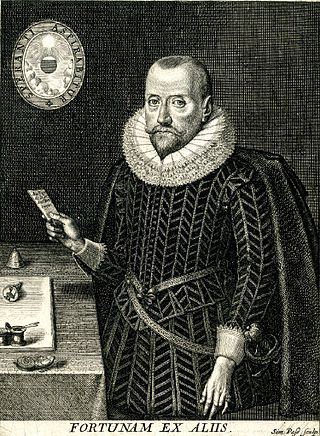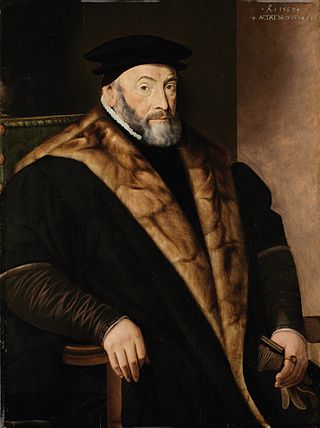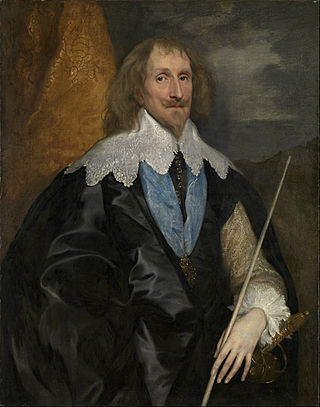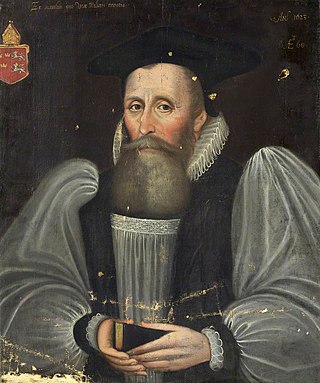
John Howard, 1st Duke of Norfolk, also known as Jack of Norfolk,, was an English nobleman, soldier, politician, and the first Howard Duke of Norfolk. He was a close friend and loyal supporter of King Richard III, with whom he was slain at the Battle of Bosworth in 1485.

Edward Montagu, 2nd Earl of Manchester, KG, KB, FRS was an important commander of Parliamentary forces in the First English Civil War, and for a time Oliver Cromwell's superior.

Sir Robert Naunton was an English writer and politician who sat in the House of Commons at various times between 1606 and 1626.

Thomas Audley, 1st Baron Audley of Walden KG, PC, KS, JP, was an English barrister and judge who served as Lord Chancellor of England from 1533 to 1544.

Edward Villiers, 1st Earl of Jersey was an English peer, courtier, and statesman of the Villiers family. He was created Baron Villiers and Viscount Villiers in 1691 and Earl of Jersey in 1697. A leading Tory politician opposed to the Whig Junto, he was made Southern Secretary in 1699.

Earl of Suffolk is a title which has been created four times in the Peerage of England. The first creation, in tandem with the creation of the title of Earl of Norfolk, came before 1069 in favour of Ralph the Staller; but the title was forfeited by his heir, Ralph de Guader, in 1074. The second creation came in 1337 in favour of Robert de Ufford; the title became extinct on the death of his son, the second Earl, in 1382. The third creation came in 1385 in favour of Michael de la Pole. The fourth creation was in 1603 for Lord Thomas Howard, the second son of Thomas Howard, 4th Duke of Norfolk, by his second wife Margaret Audley, the daughter and eventual sole heiress of Thomas Audley, 1st Baron Audley of Walden, of Audley End in the parish of Saffron Walden in Essex. Howard was a prominent naval commander and politician and served as Earl Marshal, as Lord Chamberlain of the Household and as Lord High Treasurer. In 1597 he was summoned to Parliament as Baron Howard de Walden, and in 1603 he was further honoured, at the start of the reign of King James I, when he was created Earl of Suffolk. His second son the Hon. Thomas Howard was created Earl of Berkshire in 1626.

Earl of Berkshire is a title that has been created twice in the Peerage of England. It was created for the first time in 1621 for Francis Norris, 1st Earl of Berkshire. For more information on this creation, see the Earl of Abingdon and also the Earl of Lindsey. The second creation came in 1626 in favour of Thomas Howard, 1st Viscount Andover. He was the second son of Thomas Howard, 1st Earl of Suffolk, second son of the second marriage of Thomas Howard, 4th Duke of Norfolk. His mother was Katherine, daughter of Sir Henry Knyvett of Charlton in Wiltshire. Howard had already been created Baron Howard of Charlton, in the County of Wiltshire, and Viscount Andover, in the County of Southampton, in 1622. These titles are also in the Peerage of England. Lord Berkshire succeeded to the Charlton estate through his mother in 1638. He was succeeded by his eldest son, the second Earl. He had already in 1640 been summoned to the House of Lords through a writ of acceleration in his father's junior title of Baron Howard of Charlton. He had no sons and on his death in 1679 the titles passed to his younger brother, the third Earl. He represented Wallingford in the House of Commons. He also died without male issue and was succeeded by his great-nephew, the fourth Earl. He was the grandson of the Hon. William Howard, fourth son of the first Earl. In 1745 he succeeded his third cousin as eleventh Earl of Suffolk. For further history of the titles, see the Earl of Suffolk.

Baron Braybrooke, of Braybrooke in the County of Northampton, is a title in the Peerage of Great Britain. It was created in 1788 for John Griffin, 4th Baron Howard de Walden, with remainder to his kinsman Richard Neville-Aldworth. Lord Howard de Walden was the son of William Whitwell and Anne Griffin, daughter of James Griffin, 2nd Baron Griffin of Braybrooke, who was the son of Edward Griffin, 1st Baron Griffin of Braybrooke, and his wife Lady Essex Howard, eldest daughter of James Howard, 3rd Earl of Suffolk and 3rd Baron Howard de Walden.

Thomas Howard, 1st Earl of Suffolk,, of Audley End House in the parish of Saffron Walden in Essex, and of Suffolk House near Westminster, a member of the House of Howard, was the second son of Thomas Howard, 4th Duke of Norfolk, by his second wife Margaret Audley, the daughter and eventual sole heiress of Thomas Audley, 1st Baron Audley of Walden, of Audley End.

Henry Howard, 1st Earl of Northampton was an important English aristocrat and courtier. He was suspected throughout his life of being Roman Catholic, and went through periods of royal disfavour, in which his reputation suffered greatly. He was distinguished for learning, artistic culture and his public charities. He built Northumberland House in London and superintended the construction of the fine house of Audley End. He founded and planned several hospitals. Francis Bacon included three of his sayings in his Apophthegms, and chose him as "the learnedest councillor in the kingdom to present to the king his Advancement of Learning." After his death, it was discovered that he had been involved in the murder of Sir Thomas Overbury.

Theophilus Howard, 2nd Earl of Suffolk, was an English nobleman and politician.

Thomas Howard, 1st Earl of Berkshire was an English politician who sat in the House of Commons between 1605 and 1622. He was created Earl of Berkshire in 1626.

Philip Herbert, 4th Earl of Pembroke and 1st Earl of Montgomery, was an English courtier, nobleman, and politician active during the reigns of James I and Charles I. He married Susan de Vere, the youngest daughter of Edward de Vere, 17th Earl of Oxford, the Oxfordians' William Shakespeare. Philip and his older brother William were the 'incomparable pair of brethren' to whom the First Folio of Shakespeare's collected works was dedicated in 1623.

John Preston (1587–1628) was an Anglican minister and master of Emmanuel College, Cambridge.
Henry Howard, 10th Earl of Suffolk, of Audley End, Essex, styled Lord Walden from 1731 to 1733 was a British politician who sat in the House of Commons from 1727 until 1733 when he succeeded to the peerage.
Edward Howard, 1st Baron Howard of Escrick was an English nobleman and Parliamentarian.

Nicholas Felton (1556–1626) was an English academic, the Bishop of Bristol from 1617 to 1619, and then Bishop of Ely.
Thomas Bainbrigg (Bainbridge) was an English college head.
Sir Robert Howard KB was an English landowner, member of parliament, and Royalist soldier. He was involved in a scandal when his mistress Frances Coke, Viscountess Purbeck, was found guilty of adultery and was twice summoned to explain her pregnancy with his son to the Court of High Commission. During the English Civil War, Howard was in command of the defence of Bridgnorth Castle when it surrendered to the Parliamentarians in 1646.

Sir Thomas Jermyn (1573–1645) of Rushbrooke, Suffolk, was an English Royalist soldier and politician who was a Member of Parliament between 1604 and 1640. He became an influential courtier and served as Comptroller of the Household to Charles I from 1639 to 1641.















